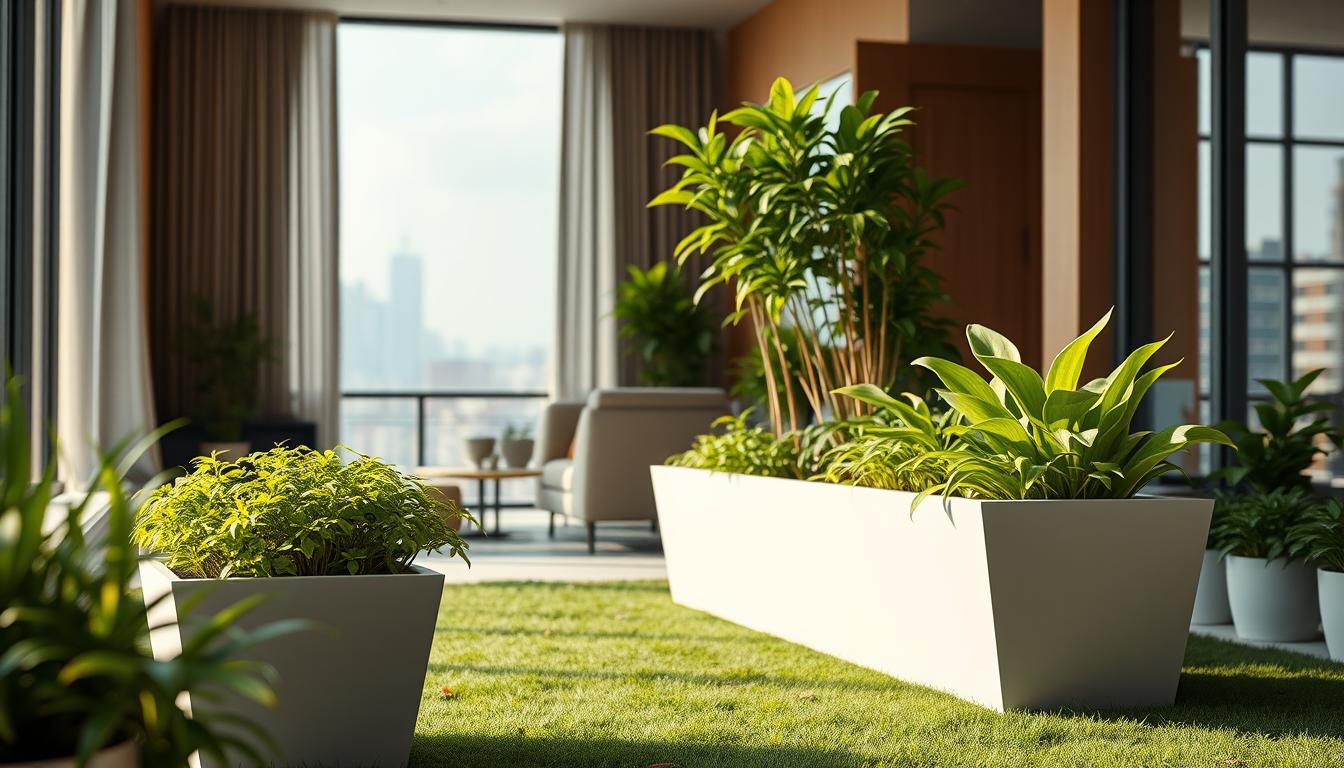Ever rushed home to save wilting plants? Or seen your garden suffer in the summer heat? These problems are common for gardeners. But, there’s a simple fix that’s making gardening easier.
Self-watering planters have changed gardening. They keep plants watered without constant checking. These containers have a reservoir that feeds water to roots as needed.
These planters also help save water. They make plants grow strong with up to 80% less water than usual.
They’re great for busy people or anyone who wants easy gardening. In this article, we’ll see why they’re key for growing plants indoors and outdoors.
The Plant Parent’s Dilemma in Today’s Fast-paced World
Modern plant parents struggle to care for their plants while dealing with busy lives. Our homes are filled with plants, but our schedules are packed. This makes it hard for even the most passionate gardeners.
Our love for plants is growing, but so is our busy lives. This makes it tough to keep plants happy. It’s not because we don’t want to, but life gets in the way.
When Life Gets in the Way of Watering Schedules
It’s common to forget about plants when we’re in a rush. Work deadlines or family emergencies can keep us away. Even the best plans can go wrong.
Even the most organized plant parents face problems. A good watering schedule can fall apart during holidays. Or, a busy week might make us forget to water.
The Hidden Damage of Inconsistent Moisture
Erratic watering can harm plants in ways we don’t see. Plants prefer steady moisture, not the ups and downs we often give them.
Roots can suffer from too little or too much water. This can stunt growth or cause rot. Plants may also get sick more easily.
These problems don’t show up right away. They build up over time. Plants may not grow well, even with our best care. Sustainable gardening is all about consistent care, which is hard in our fast-paced world.
Self-watering Planters: The Revolutionary Solution
Self-watering planters have changed how we care for plants. They solve the problem of not knowing when to water. These planters let plants get the water they need, when they need it.
For those who are always busy, these planters are a big help. They make sure plants get enough water without needing a strict schedule.
Understanding the Technology Behind the Magic
Self-watering planters work like nature’s own water systems. They water plants from the bottom up. This lets plants take water as they need it.
This method lets plants control their own water use. It’s like a mini-ecosystem in each planter. Water moves through the soil based on the plant’s needs.
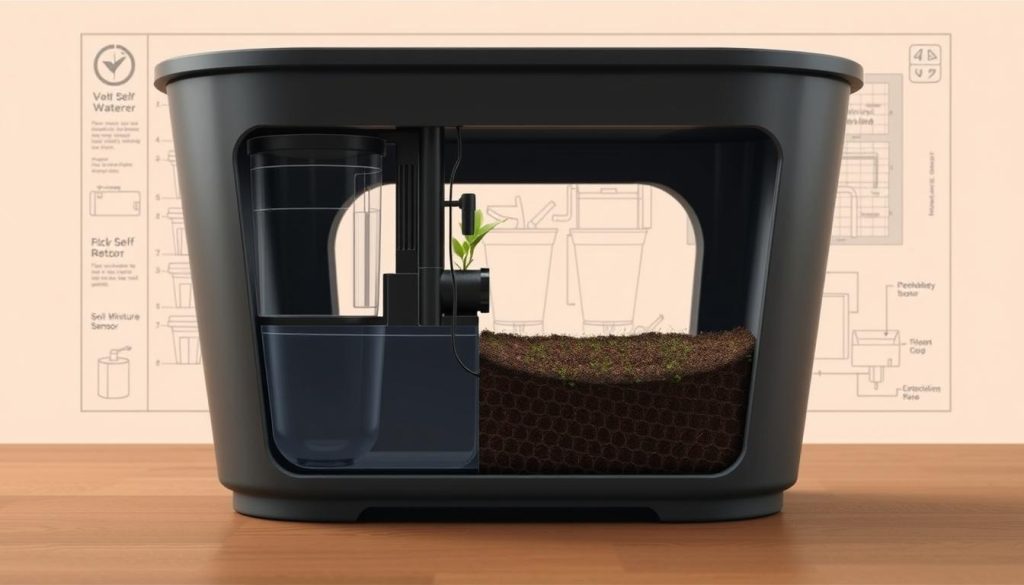
Essential Components That Make It Work
Self-watering planters might seem magical, but they have key parts. Knowing these parts helps you pick the right planter and fix any problems.
Water Reservoir Design
The heart of a self-watering planter is its water reservoir. This chamber holds water below the soil. Reservoirs come in different sizes and designs, some with water level indicators.
The best reservoirs are big enough to last a few days but not so big they flood the system.
Wicking Systems and Capillary Action
Wicking systems connect the reservoir to the soil. They use capillary action to pull water up to the roots. Materials like cotton rope or felt help water move up.
Wicking materials can control how much water flows. Some keep the soil moist, while others release water slowly. This means no need for pumps or timers.
Overflow Protection Features
Good design includes features to stop water from overflowing. These are important to keep the soil moist but not too wet. Too much water can harm the roots.
Many planters also have aeration screens. These screens keep the water reservoir separate from the soil. They let roots get to the water while keeping the soil healthy.
The Science of Self-regulating Moisture Systems
Self-regulating moisture systems blend physics, biology, and sustainable gardening. They make caring for plants easier by creating perfect growing conditions. Understanding their science shows why they keep plants healthy with little effort.
How Water Moves from Reservoir to Roots
Water moves from reservoir to roots through capillary action and osmosis. Capillary action is like a paper towel soaking up spills. In these planters, a wicking material pulls water up against gravity.
This wicking material, often made of rope or fabric, acts as a moisture highway. Water spreads through the soil, keeping it moist around the roots.
Different soils affect water movement. Sandy soils let water move fast but don’t hold it well. Clay soils hold water but slow it down. Self-watering planters use special mixes that balance water and air.
The Perfect Balance: Never Too Wet or Dry
Plants need the right amount of moisture. Too much causes rot, too little causes stress. These systems find this balance automatically.
Soil’s air spaces play a key role. When moist, it has water and air pockets. As plants use water, more air enters, pulling more water up.
When soil is moist enough, this pull slows down. It’s a self-regulating loop that responds to soil conditions. This mimics natural systems where plants get water as needed.
Plant-driven Watering vs. Timer-based Systems
Self-watering planters use plant-driven watering. They respond to plant needs, unlike timers that water on a schedule. This makes them more efficient.
In these systems, plants control water uptake. On hot days, they need more water, pulling it from the reservoir. On cooler days, they need less.
| Feature | Plant-driven Systems | Timer-based Systems | Environmental Impact |
|---|---|---|---|
| Water Efficiency | High – water used only as needed | Medium to Low – often overwatering | Plant-driven systems reduce water waste |
| Response to Weather | Automatic adjustment | No adjustment unless reprogrammed | Adaptive systems support sustainable horticulture |
| Plant Health | Consistent moisture levels | Fluctuating moisture levels | Stable conditions reduce plant stress |
| Technology Required | Simple physics principles | Electronic timers and valves | Simpler systems have lower carbon footprint |
This approach is the best in sustainable gardening. It lets plants control their water, avoiding underwatering and overwatering. Plants grow stronger and healthier.
These systems are not just convenient. They work with plant biology, creating better growing conditions. They save water and reduce the need for maintenance.
Why Self-watering Planters Are a Game-changer for Home Gardeners
Home gardeners are finding that self-watering planters change the game. They offer more than just convenience. These containers make gardening more sustainable, efficient, and stress-free. Let’s see why they’re key for modern gardeners.
Freedom to Travel Without Plant Worry
Ever worried about your plants when you’re away? Self-watering planters solve this problem. They have water reservoirs that last for days or weeks. So, you can travel without worrying about your plants.
Now, a weekend trip or a two-week vacation won’t stress your plants. They’ll stay healthy and strong while you’re away. Your plants will thrive without you needing to check on them.
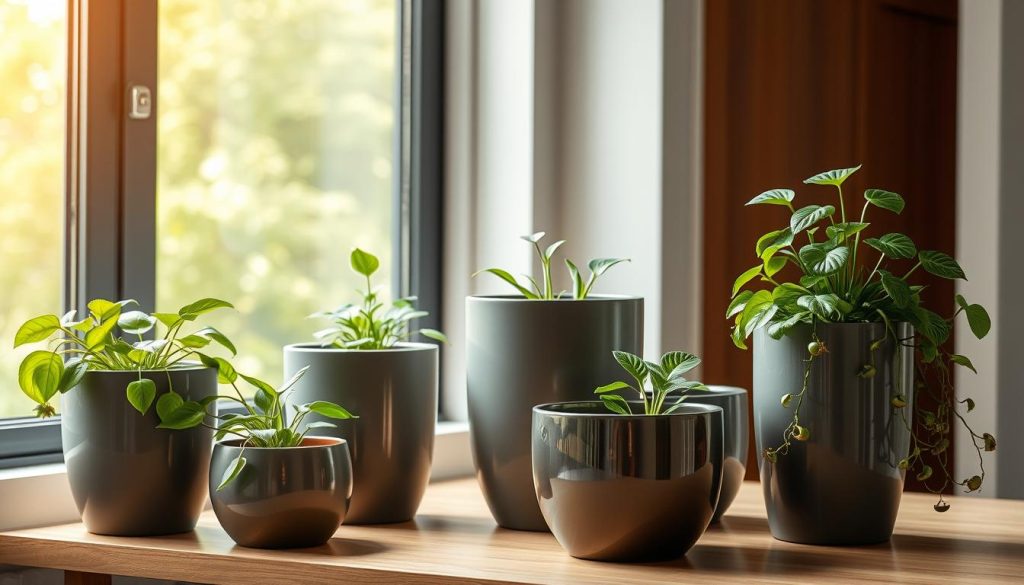
Consistent Growth Patterns and Healthier Plants
Plants love consistency, and self-watering planters provide it. They keep the soil moist, avoiding drought and flood damage. This steady moisture helps plants grow strong and healthy.
With self-watering planters, plants spend less time recovering from water stress. They focus more on growing, leading to greener, fuller plants. You’ll see fewer yellow leaves and more blooms.
Significant Water Conservation Benefits
Self-watering planters are great for saving water. They deliver moisture directly to the roots, reducing evaporation. This makes them perfect for drought-resistant gardening.
These planters use 30-50% less water than regular pots. Their design keeps excess moisture in, preventing runoff. This saves water and reduces waste.
Reduced Fertilizer Waste and Runoff
Traditional watering often wastes fertilizers. Self-watering planters keep nutrients in the soil longer. This means plants use more of what they need, reducing waste.
Using less fertilizer means better results for your plants. Plus, it helps prevent pollution in local waterways. Excess fertilizer can harm water quality, but self-watering planters prevent this.
Exploring the Variety of Self-watering Systems
Today, we see many self-watering systems for different plants and lifestyles. Whether you’re always on the go or want to keep your plants healthy, there’s a system for you. Let’s look at the many options and find the best one for you.
Traditional Reservoir Containers
Self-watering starts with traditional reservoir containers. They have a water tank at the bottom, separated from the soil. This setup keeps the soil moist by using capillary action.
These containers are made from plastic, ceramic, or composite materials. They come in all sizes, from small herb planters to big garden boxes. Their simplicity and reliability make them a great choice.
Most have a water level indicator. This lets you know when it’s time to add more water. They’re perfect for plants that like steady moisture, like tomatoes and houseplants.
Modern Hydroponic Adaptations
Hydroponic systems take self-watering further by removing soil. Plants grow in water or media like coconut coir. This method gives plants nutrients directly, leading to faster growth and more yields.
Hydroponics include passive and active systems. Even beginners can find easy-to-use systems. They’re great for growing leafy greens and veggies.
Smart Planters with Moisture Sensors
Smart planters combine gardening with technology. They have moisture sensors that check soil conditions constantly. Some even connect to apps on your phone, so you can check on your plants from anywhere.
These smart systems also have automated water pumps. Some even track light, temperature, and nutrients. They’re perfect for those who love tech and want to care for their plants precisely.
Decorative Options for Style-conscious Gardeners
Self-watering doesn’t mean you have to give up style. Today, you can find beautiful planters that look great and work well. From sleek designs to colorful planters, there’s something for everyone.
Vertical gardens and designer planters are popular. They add to your home’s look while keeping plants healthy. Materials like bamboo and terracotta add to their appeal.
These planters are great for indoor spaces. They make a statement while providing the best growing conditions.
| System Type | Best For | Maintenance Level | Price Range | Key Benefits |
|---|---|---|---|---|
| Traditional Reservoir | Most houseplants, vegetables | Low | $15-$50 | Simplicity, reliability, widely available |
| Hydroponic Systems | Herbs, leafy greens, fast-growing plants | Medium | $30-$200 | Faster growth, higher yields, water efficiency |
| Smart Planters | Rare or finicky plants, busy gardeners | Low (but tech-dependent) | $50-$300 | Precision watering, remote monitoring, data insights |
| Decorative Options | Living spaces, offices, visible areas | Low to Medium | $25-$150 | Aesthetic appeal, conversation pieces, space optimization |
Perfect Plant Companions for Water Reservoir Planters
Choosing the right plants for your water reservoir planters is key. These systems make watering easy, but not all plants like it. Knowing which plants need steady water helps you create a low-maintenance garden.
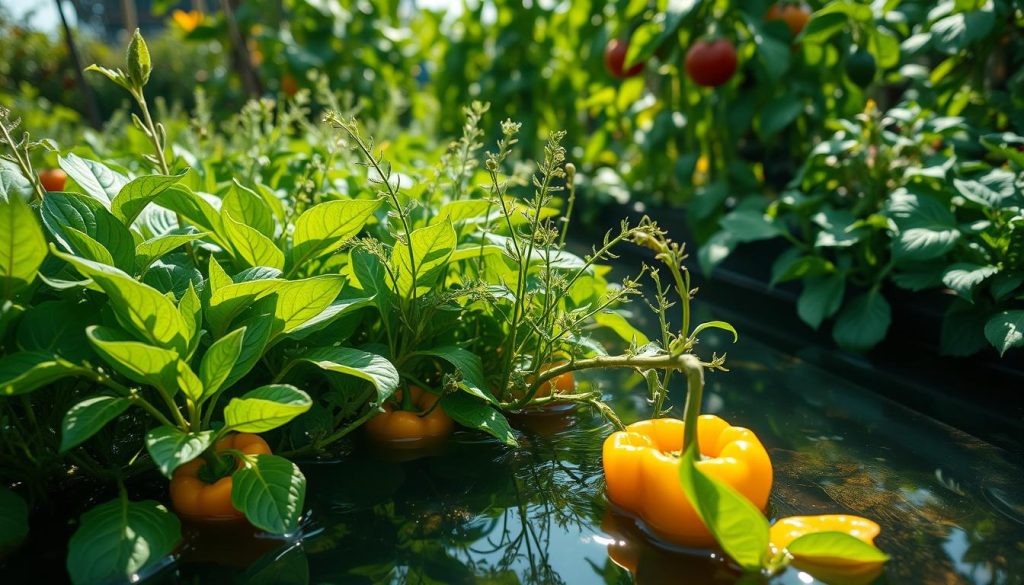
Vegetables That Thrive in Consistent Moisture
Many vegetables love the steady water in water reservoir planters. Tomatoes, for example, grow sweeter with consistent watering. Cherry tomatoes like ‘Sweet 100’ and ‘Sun Gold’ do great in these containers.
Bell and hot peppers also do well with regular water. They grow more when they don’t get stressed from dryness. Leafy greens like spinach, kale, and Swiss chard love the moist environment, growing longer than usual.
Herbs such as basil, mint, cilantro, and parsley love the moist air in water reservoir planters. Their shallow roots get the water they need, leading to more frequent harvests and less bolting in hot weather.
Houseplants Made for Self-watering Success
Indoor gardening gets easier with self-watering planters and the right plants. Peace lilies, for instance, stay healthy and flower more in these systems. They don’t droop as much, showing they’re happy.
Pothos and philodendron grow faster and bigger in reservoir systems. Spider plants, with their water-storing roots, also thrive in the steady moisture.
Ferns like Boston ferns and maidenhair ferns are easier to care for in self-watering systems. They come from moist forests, making them a perfect fit.
Plants That Prefer Traditional Watering Methods
Not every plant likes the constant moisture of water reservoir planters. Succulents and cacti need dry spells to survive. Putting them in self-watering containers can harm them.
Mediterranean herbs like rosemary, thyme, and sage prefer to dry out a bit between waterings. This makes their flavors stronger. In self-watering systems, they can become weak and lose their taste.
Orchids and some tropical plants need special care that self-watering systems can’t provide. They require specific watering and air circulation around their roots.
| Plant Type | Self-Watering Compatibility | Water Needs | Best Varieties |
|---|---|---|---|
| Leafy Greens | Excellent | Consistent moisture | Spinach, Kale, Lettuce, Swiss Chard |
| Fruiting Vegetables | Very Good | Even moisture, slight variation | Cherry Tomatoes, Bell Peppers, Eggplant |
| Tropical Houseplants | Excellent | Consistent moisture | Pothos, Peace Lily, Spider Plant |
| Succulents/Cacti | Poor | Drought cycles needed | Aloe, Echeveria, Barrel Cactus |
| Mediterranean Herbs | Fair to Poor | Needs to dry between waterings | Rosemary, Thyme, Sage, Lavender |
Creating Your Own Self-watering Solutions
Making your own self-watering solutions is rewarding and eco-friendly. It saves money and lets you tailor systems for your plants. With creativity and basic materials, you can start your sustainable gardening journey at home.
Upcycled Container Projects Anyone Can Make
Turning everyday items into planters is simple. Plastic bottles can be cut in half to create mini self-watering systems. The top part is placed upside down in the bottom to hold water.
Yogurt tubs can be turned into self-watering planters with a wick. Drill a hole in the lid, thread a wick through, and place it under the tub. The wick pulls water up to your plants.
Five-gallon buckets are great for bigger plants. Nesting one inside another with space in between makes a big water reservoir. Add a fill tube and drainage holes for the inner bucket.
Weekend Builds for Serious Gardeners
For more complex projects, try building a multi-container system. It’s perfect for balcony gardens or patios.
Adapting raised beds into self-watering systems is another great idea. Add a liner and a PVC pipe false bottom for the reservoir. This cuts down on watering for your veggies.
Custom solutions can include wicking beds for herbs or vertical systems for trailing plants. These projects take a weekend but last for years.
Cost-effective Materials and Tools
DIY self-watering planters are affordable. You can use cotton rope or capillary mats, or even old t-shirts for free.
Repurposed items are free, while food-grade buckets cost $3-8. You’ll need a drill, utility knife, and measuring tape, which are all affordable.
The right growing media is key. A mix of potting soil, perlite, and coconut coir is ideal. It costs $15-20 for enough to fill several containers. Don’t worry if your first try isn’t perfect. The journey of creating sustainable gardening solutions is just as rewarding as the end result.
Transforming Indoor Gardening with Automated Irrigation
Technology has changed indoor gardening with automated irrigation. It’s great for those living in apartments or offices. Now, city folks can enjoy growing plants without sacrificing their busy lives.
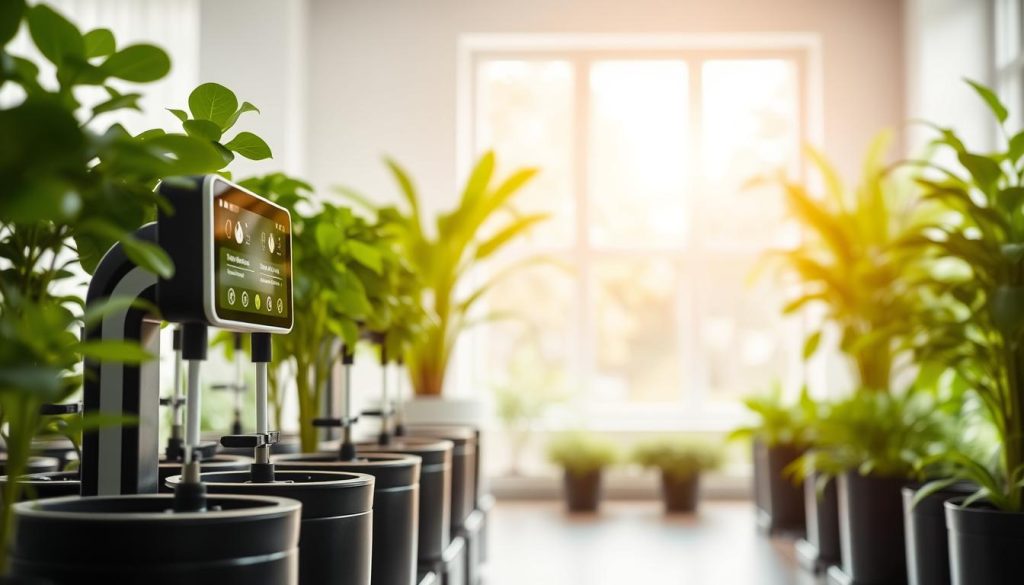
Small-space Solutions for Urban Dwellers
Living in the city doesn’t mean you can’t garden. Vertical systems use wall space well, saving floor area. They turn blank walls into green spaces.
Window planters use natural light and save space. They fit well on windowsills. Some even have grow lights for darker spots.
Stackable containers are perfect for renters. They grow or shrink with your space. They’re easy to move too.
Stylish Self-watering Options for Modern Homes
Today’s systems look good and work well. Sleek planters hide the water reservoir. They match modern decor without looking like watering cans.
Modern designs use glass and metal. They show off plants and roots. The clear parts make watering a part of the decor.
Customizable planters fit any style. You can change them with the seasons. They’re a stylish addition to any room.
Office-friendly Systems for Workspace Greenery
Offices have their own gardening challenges. Automated systems solve these problems. They work well with office lighting and temperature.
Desktop gardens last through weekends. They have special soil to hold water. This prevents spills on work.
Big systems have smart sensors. They adjust to office conditions. Some even connect to apps for plant monitoring.
| System Type | Space Requirement | Maintenance Needs | Ideal Environment | Best Plant Types |
|---|---|---|---|---|
| Vertical Wall Systems | Minimal floor space | Monthly reservoir refill | Apartments, small homes | Herbs, small ferns, succulents |
| Smart Pot Sensors | Same as regular pots | Battery replacement (6-12 months) | Modern homes, tech-savvy users | Most houseplants |
| Hydroponic Towers | 2-3 sq. ft. floor space | Weekly nutrient monitoring | Bright kitchens, sunrooms | Leafy greens, small vegetables |
| Office Desktop Systems | Under 1 sq. ft. | Bi-weekly water checks | Workspaces, cubicles | Peace lilies, pothos, snake plants |
Automated irrigation makes gardening easy for everyone. It’s great for city folks, design lovers, and office workers. Now, anyone can enjoy indoor gardening, no matter their space or schedule.
Overcoming Common Challenges with Self-watering Systems
Learning to use self-watering planters can be tricky. But with the right knowledge, you can avoid common problems. This way, you can enjoy the benefits of these smart gardening solutions without stress.
Preventing the Dreaded Root Rot
Root rot is a big worry for those who love self-watering planters. It happens when the soil stays too wet. This can happen if your system isn’t set up right.
To stop root rot, use a potting mix that drains well. Add perlite or vermiculite to help. Don’t pack the soil too tight, as it cuts off oxygen to the roots. Keep the water level right, not too high.
If your plant starts to look sick, act fast. Take it out, cut off bad roots, and put it in new soil. Make sure the water level is lower this time.
Managing Salt Buildup in Reservoirs
Over time, self-watering systems can get a buildup of salts. This looks like a white crust on the soil or the container. It can stop your plants from getting the nutrients they need.
Every 3-4 months, clean your system by watering it from the top. This lets water drain out. For salt buildup, empty the reservoir and clean it with vinegar and water. Then, rinse it well.
Winterizing Your Self-watering Containers
Freezing weather can hurt your self-watering planters if you’re not careful. For outdoor containers, drain the water before the first frost. If you can, remove the water level indicator, as it can freeze.
For ceramic or terracotta planters, move them inside. Plastic ones can stay outside if you empty them. But, wrapping them in bubble wrap helps keep the roots warm.
Troubleshooting Water Level Indicators
Water level indicators are important but can sometimes go wrong. Usually, fixing them is easy.
For cloudy windows, use a pipe cleaner to clean the inside. If the indicator floats and sticks, clean it with soap. This removes algae or minerals that cause it to stick.
| Common Issue | Possible Cause | Solution | Prevention |
|---|---|---|---|
| Root Rot | Excessive moisture | Reduce water level, replace soil | Use well-draining soil mix |
| Salt Buildup | Fertilizer accumulation | Flush system with clean water | Regular reservoir cleaning |
| Frozen Components | Winter exposure | Replace damaged parts | Drain system before frost |
| Inaccurate Indicator | Mineral deposits | Clean with vinegar solution | Monthly indicator maintenance |
Most problems with self-watering planters can be avoided with regular care. By following these simple steps, you can enjoy these smart gardening solutions all year.
Self-watering vs. Traditional: An Honest Comparison
Self-watering planters are becoming more popular. They raise a key question: how do they compare to traditional gardening? As gardening solutions get smarter, knowing the differences helps you choose what fits your lifestyle and values. Let’s look at both sides to see which one meets your gardening needs.
Initial Investment vs. Long-term Savings
Self-watering planters cost 30-50% more than traditional ones at first. A good self-watering pot might be $25-45, while a similar traditional pot is $15-30. But, the cost changes over time.
- Water savings: Self-watering systems use 30-60% less water, saving on bills
- Plant replacement: They lose fewer plants, so you buy fewer new ones
- Fertilizer efficiency: They use 20-40% less fertilizer
Most gardeners get their money back in 1-2 growing seasons. This is true, mainly in areas with high water costs or during droughts.
Environmental Impact Assessment
The environmental impact of your garden matters. Self-watering systems have some benefits, but traditional methods have their own strengths.
Water conservation is a big win for self-watering planters. They can save up to 60% of water compared to traditional methods. Yet, many use more plastic than terracotta pots.
Self-watering systems with pumps or electronics use energy, but solar options help. Traditional methods are better for the environment when using natural materials like clay or wood.
Plant Health and Growth Differences
Research shows self-watering systems have several benefits for plants:
- 15-30% faster growth for most vegetables and herbs
- Less disease from irregular watering
- More consistent fruit and flower production
- Longer growing seasons for container vegetables
Plants that like soil to dry between waterings, like succulents, do better in traditional pots. Mediterranean herbs like rosemary and lavender prefer drying cycles of traditional pots.
The Time-saving Reality
Busy gardeners save a lot of time with self-watering systems. Traditional gardening needs daily watering checks, taking 20-30 minutes a day for a small garden.
Self-watering systems need just a weekly check, taking 5-10 minutes. This cuts down maintenance time by 80-90%. For those growing food, this saves time all season long.
For city gardeners or those with tight schedules, these solutions make gardening easier. They turn plant care into a weekly task, making gardening possible for those who might not have time.
Why I Believe Every Gardener Should Embrace Drought-resistant Gardening Technology
Exploring self-watering planters has shown me their value. They’re not just convenient; they open doors to sustainable gardening for all. With our climate changing, saving water is crucial, making drought-resistant gardening essential.
These systems make gardening accessible to everyone. No longer is it only for those with perfect schedules or lots of experience. Busy people, travelers, or new gardeners can now grow beautiful gardens easily.
Self-watering tech works like nature. Plants get just what they need, when they need it. This saves water, using up to 80% less than traditional methods.
These systems improve plant health. Plants stay moist, grow strong roots, and handle heat better. This also helps the environment by reducing water waste and plastic use.
Adopting these innovations doesn’t mean giving up gardening’s joy. It makes gardening better by avoiding the pain of dead plants. As water rules get stricter and weather gets wilder, these techs guide us forward. They respect our love for plants and our duty to Earth.
Your garden and our future need this technology.

